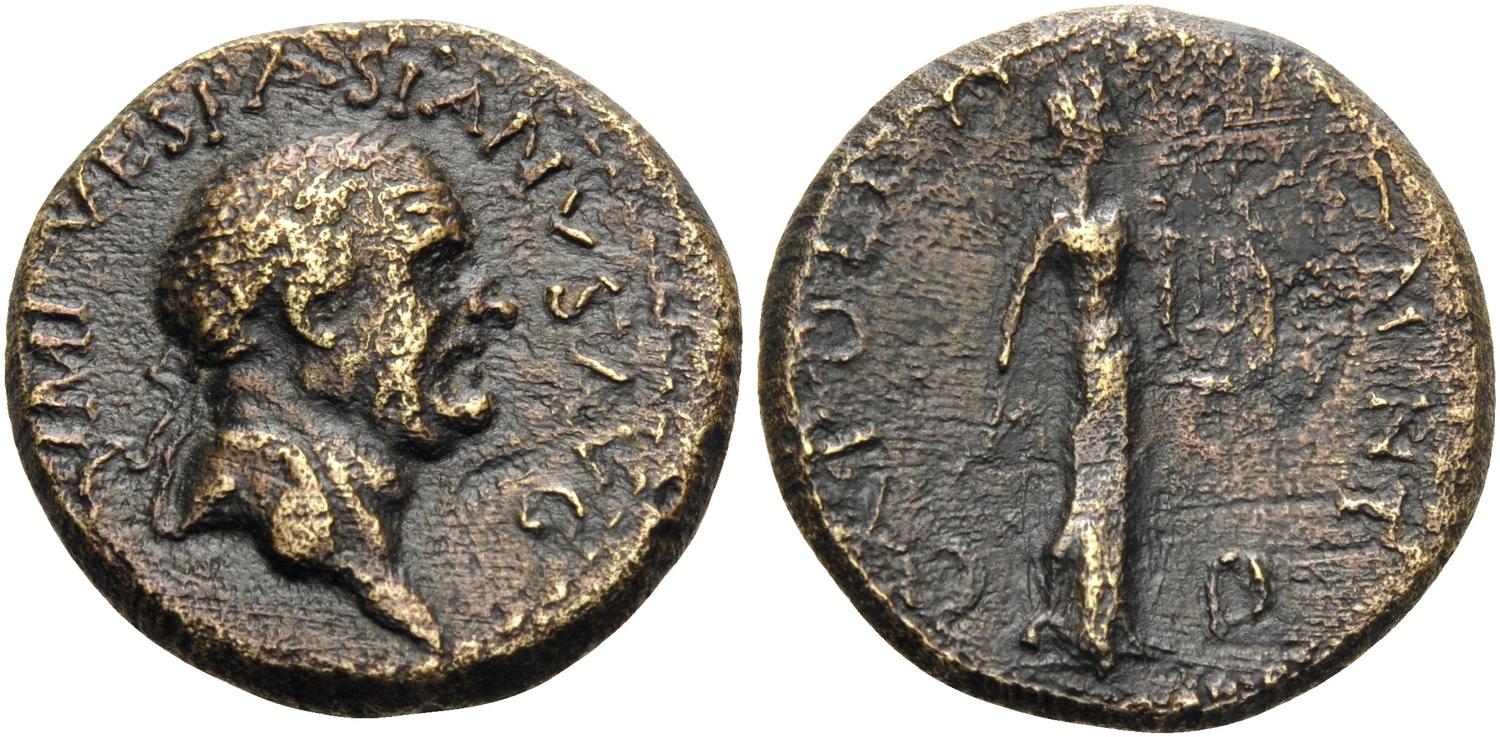Alexandria Troas, bronze, 5g (Vespasian/Apollo) (69-79 CE)
From SILVER
69 CE - 79 CE Bronze
Description
| ObverseInscription or printing placed on the obverse.: | IMP VESPASIANVS AVG (latin).Laureate head of Vespasian to right |
| ReverseInscription or printing placed on the reverse.: | VICTORIA AVG DD ou APOLLO ZMIN DD (latin).Apollo Smintheus standing to right, holding plectrum and lyre |
Mint and issuing power
| MintIdentifies the place of manufacture or issue of a numismatic object.: | Alexandria Troas | Ancient regionAncient region.: | Troas | Modern countryModern country: Turkey | AuthorityIdentifies the issuing power. The authority can be "pretended" when the name or the portrait of X is on the coin but he/she was not the issuing power. It can also be "uncertain" when there is no mention of X on the coin but he/she was the issuing power according to the historical sources: | Vespasian (Roman emperor, 69-79 AD) |
Chronology
| FromIdentifies the initial date in a range assigned in a numismatic context. | 69 CE | toIdentifies the final date in a range assigned in a numismatic context.. | 79 CE | PeriodTime period of the numismatic object.: Roman from 30 BC |
Physical description
| MetalThe physical material (usually metal) from which an object is made.: | Bronze |
Median weightMedian of the weights of numismatic objects (in grams). in grams | 5.00 | DenominationTerm indicating the value of a numismatic object. Examples: tetradrachm, chalkous, denarius.: | StandardStandard.: |
Image

RQEM ad. 731 - Alexandria Troas, bronze, NC, 69-79 BC.jpg [1]
References
| Die study referencePublication of the study: | Burnett 19981Burnett 1998 | ||
| Coin series referenceReference to coin series study: | |||
| Coin series web referenceCoin series web references: | |||
Obverse dies distribution
| FrequencyFrequency of specimen in distribution. ᵖ | Number of obversesNumber of obverse dies. ᵖ (o) | % (o) | Number of coinsNumber of coins. (n) | % (n) | Die nameName(s) of the die(s). |
| 1 | 2 | 40 | 2 | 25 | |
| 2 | 3 | 60 | 6 | 75 | |
| Total | 5 of 5 | 100 | 8 of 8 | 100 |
Reverse dies distribution
no distribution is available
Quantification
| Number of obversesNumber of obverse dies. ᵖ (o) | 5 | Number of singletons (o1)The number of singleton coins. ᵖ | 2 |
| Number of reverse diesNumber of reverse dies. (r) | 5 | Number of coinsNumber of coins. (n) | 8 |
| Coins per obverse dieNumber of coins per obverse die. (n/o) | 1.6 | Coins per reverse dieNumber of coins per reverse die. (n/r) | 1.6 |
| Reverse per obverse ratioRatio of obverse dies divided by reverse dies. (r/o) | 1 | Percentage of singletons (o1)number of coins (n) divided by the number of singletons (o1) ᵖ | 40 % |
| Original number of dies (O) (Carter 1983 formula)The estimation of the number of coins according to Carter 1983 ᵖ | 10.73 | Coins struck if 20,000 as average productivity per dieCoins made if the average productivity for obverses (according to Carter) is 20,000. ᵖ | 214,600 |
| Original number of dies (O) (Esty 2011 formula)The estimation of the number of coins according to the singleton formula in Esty 2011 ᵖ (O) | 13.33 | Survival rate if 20,000 as average productivity per dieSurvival rate if average productivity is 20,000. ᵖ | 0.00004 |
| Coverage (o = % of O) (Esty 1984 formula)Esty 1984 - coverage (% of O) ᵖ (o = % of O) | 75% | Die productivity if survival rate 1/2,000Average productivity if survival rate is 1/2,000. ᵖ | 1,491.15 |
| Weight of silver (in kg) if 20,000 coins per die (O = Carter formula)Carter 1983 * Median weight * 20000 (*10 if gold or electrum) ᵖ | n.a. | Die productivity if survival rate 1/5,000Average productivity if survival rate is 1/5,000. ᵖ | 3,727.87 |
Remarks
References
- ^ Burnett, Andrew M. (1998), "The earliest coinage of Alexandria Troas", in U. Peter (ed.), Stephanos nomismatikos : Edith Schönert-Geiss zum 65. Geburtstag, Berlin, 1998, p. 165-168.